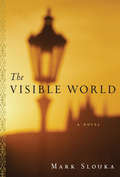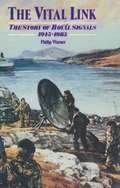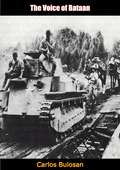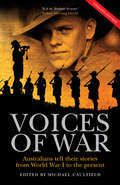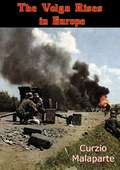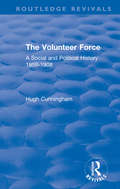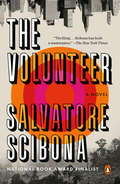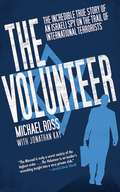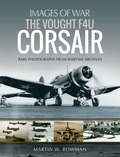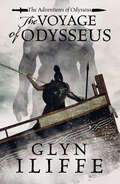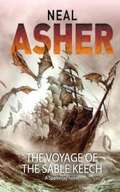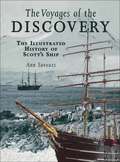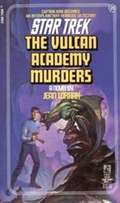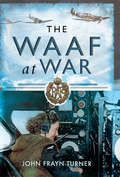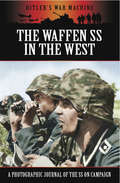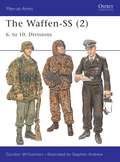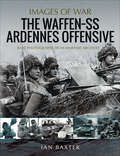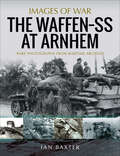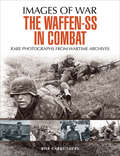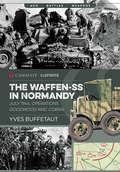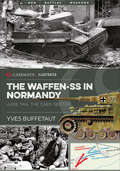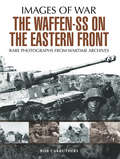- Table View
- List View
The Visible World: A Novel
by Mark Slouka&“A vibrantly told love story&” with tragic roots in WWII Czechoslovakia (The Washington Post). An American-born son of Czech immigrants grows up in postwar New York, part of a boisterous community of the displaced where he learns fragments of European history, Czech fairy tales, and family secrets gleaned from overheard conversations. Central in his young imagination is the heroic account of the seven Czech parachutists who, in 1942, assassinated a high-ranking Nazi. Yet one essential story has always evaded him: his mother&’s. He suspects she had a great wartime love, the loss of which bred a sadness that slowly engulfed her. As an adult, he travels to Prague, hoping to piece together her hidden past—leading to the compelling story at the heart of The Visible World—an &“almost unbearably poignant work . . . a penetrating, beautifully composed novel from a writer with a tangible sense of place and period,&” the acclaimed author of Brewster and God&’s Fool, named a Best Book of the Year by the San Francisco Chronicle (Booklist). &“The sheer beauty of Mark Slouka&’s prose will draw comparisons to The English Patient.&” —Gary Shteyngart, New York Times–bestselling author of Super Sad True Love Story &“A book that will last.&” —Colum McCann, National Book Award–winning author of Let the Great World Spin
The Visitors
by Caroline ScottFrom the highly acclaimed author of The Photographer of the Lost, a BBC Radio 2 Book Club Pick, comes a tale of a young war widow and one life-changing, sun-drenched visit to Cornwall in the summer of 1923... Esme Nicholls is to spend the summer in Cornwall. Her late husband Alec, who died fighting in the war, grew up in Penzance, and she&’s hoping to learn more about the man she loved and lost. While there, she will stay with Gilbert, in his rambling seaside house, where he lives with his former brothers in arms. Esme is fascinated by this community of eccentric artists and former soldiers, and as she gets to know the men and their stories, she begins to feel this summer might be exactly what she needs. But everything is not as idyllic as it seems – a mysterious new arrival later in the summer will turn Esme&’s world upside down, and make her question everything she thought she knew about her life, and the people in it.Full of light, laughter and larger-than-life characters, The Visitors is a novel of one woman finally finding her voice and choosing her own path forwards. Praise for Caroline Scott: &‘A page-turning literary gem&’ The Times, Best Books of 2020 'A touching novel of love and loss' Sunday Times 'A beautifully written must-read' heat 'A gripping, devastating novel' Sarra Manning, RED &‘A powerful novel&’ Good Housekeeping &‘A heartbreaking read&’ Anita Frank 'Breathtaking exploration of loss, love and precious memories&’ My Weekly, Pick of the Month &‘Achingly moving and most beautifully written&’ Rachel Hore &‘This beautiful book packs a huge emotional punch&’ Fabulous &‘Drew me in from the first line and held me enthralled until the very end' Fiona Valpy &‘Quietly devastating' Daily Mail 'A compulsive, heart-wrenching read' Liz Trenow &‘Powerful&’ Woman & Home 'Page turning, mysterious, engrossing and compelling' Lorna Cook &‘A carefully nuanced, complex story&’ Woman&’s Weekly &‘Caroline Scott evokes the damage and desolation of the Great War with aching authenticity' Iona Grey &‘Poignant&’ Best 'Momentous, revelatory and astonishing historical fiction!' Historical Novel Society &‘Wonderful and evocative&’ Suzanne Goldring &‘Based on true events, this is a powerful story&’ Bella &‘Immersive, poignant, intricately woven&’ Judith Kinghorn &‘An evocative read&’ heat &‘The story left me breathless&’ Kate Furnivall &‘A poignant hymn to those who gave up their lives for their country and to those who were left behind&’ Fanny Blake 'I was utterly captivated by this novel' Isabelle Broom
The Vital Link: The Story of Royal Signals, 1945–1985
by Philip WarnerTo maintain the link of communication between battlefields and HQ, between commanders and soldiers, between physically distant Corps is the vital job of the Royal Signal. But the responsibility of the Signals extends beyond the logistical requirements of inter-personal contact Electronic Intelligence and Electronic Warfare are major departments within the organisation, each of which supports the other. The Vital Link examines these diverse aspects and traces the complex developments in techniques, technology and signals tactics since the Second World War. The book, however, is more an historical story then an exhaustive tract for reference purposes. It records the growth of the Signals through its people, the 'high quality' ordinary solder to the odd character, all of whom help to define the Royal Signals. With anecdotes from individual's achievements, both personal and professional, the history of this essentially military branch is presented in an accessible and enjoyable manner.
The Voice of Bataan
by Carlos BulosanThe Battle of Bataan represented the most intense phase of the Japanese invasion of the Philippines during World War II. It began in January 1942, when forces of the Imperial Japanese Army and Navy invaded Luzon along with several islands in the Philippine Archipelago after the bombing of the American naval base at Pearl Harbor, and culminated in the fall of Bataan on April 9, 1942.The present volume, which was first published in 1943, is a collection of poetry by Filipino-American novelist and poet Carlos Bulosan, written during the Second World War. It is his tribute to the soldiers who died fighting in the Battle of Bataan.“Poems of Bataan—of that ‘small island of ashes and dead bodies,’ of the soldiers that resisted to the last man, of the hope of freedom once again. Impassioned lyrical expression of that struggle and the refusal to be conquered”—Kirkus Review
The Voices of War: Australians Tell Their Stories From World War I to the Present
by Michael CaulfieldDrawn from engagements ranging from World War I through to operations in East Timor and Iraq, these stories are taken from the Australians at War Film Archive, a collection of the memories of more than 2000 Australians who have served, both on the front line and at home. Some are unbelievably, unbearably tragic, even after sixty or seventy years; others are the golden memories of happy, albeit unusual, times. And, more often than not, they are stories that have never been shared with others, even family members. There are stories from winners of the Victoria Cross; from the POW camps of Asia and Europe; from the patrols of Vietnam, through to those who served as peacekeepers in Rwanda and Somalia. There are stories from nurses, from those who have volunteered to serve with aid agencies and stories of ordinary Australians caught up by circumstances and by duty, in wartime. These are their words.
The Volga Rises In Europe
by David Moore Curzio MalaparteImprinted on the ice, stamped on the transparent crystal beneath the soles of my shoes, I saw a row of exquisitely beautiful human faces: a row of diaphanous masks, like Byzantine icons. They were looking at me, gazing at me...the delicate, living shadows of men who had been swallowed up in the mysterious waters of the lake.DURING THE SUMMER OF 1941, the Italian journalist and novelist Curzio Malaparte was the only frontline war correspondent in the whole of Russia. His account of events there is not unique for this reason alone: his astonishing eye for detail and intimate knowledge of the country lends his record a depth of understanding rarely found in other war reporting, and his attention to the human dimension of the conflict reveals him as a man of great humanity and compassion.Expelled from the southern war zone on the orders of Goebbels in September 1941, Malaparte spent four months under house arrest before being sent to cover events in Finland. From here he reported the Siege of Leningrad--one of the seminal events played out on the Eastern Front.
The Volunteer Force: A Social and Political History 1859-1908 (Routledge Revivals)
by Hugh CunninghamOriginally published in 1975, The Volunteer Force is a study of the part-time military force which came into being to meet the mid-nineteenth century fear of French invasion. It survived and grew for fifty years until in 1908 it was renamed and remodelled as the Territorial Force. Composed initially of middle-class and often middle-aged gentlemen who elected their own officers and paid for their own equipment, the Volunteer Force soon became youthful and working-class, with appointed middle-class officers, a Government subsidy, and a minor military role as an adjunct to the Regular Army. This book examines the origins of the Force, the transformation in its social composition, the difficulties in finding officers who were ‘gentlemen’, the ambiguous status, of the Force both in the local community and in the Regular Army, and the political influence which the Force exerted in the early twentieth century. Above all it is concerned with the reasons for and the implications of enrolment; publicists argued that the Force was the embodiment of patriotism, and an indication of working-class loyalty to established institutions.
The Volunteer: A Novel
by Salvatore Scibona"His sentences are perfect but not merely; a surplus of dark and tender wisdom, who knows its source, makes his language--and the world--glow with meaning." -- Rachel Kushner, author of The Mars RoomA long-awaited new novel from a National Book Award Finalist, the epic story of a restless young man who is captured during the Vietnam War and pressed into service for a clandestine branch of the United States government A small boy speaking an unknown language is abandoned by his father at an international airport, with only the clothes on his back and a handful of money jammed in the pocket of his coat. So begins The Volunteer. But in order to understand this heartbreaking and indefensible decision, the story must return to the moment, decades earlier, when a young man named Vollie Frade, almost on a whim, enlists in the United States Marine Corps to fight in Vietnam. Breaking definitively from his rural Iowan parents, Vollie puts in motion an unimaginable chain of events, which sees him go to work for insidious people with intentions he cannot yet grasp. From the Cambodian jungle, to a flophouse in Queens, to a commune in New Mexico, Vollie's path traces a secret history of life on the margins of America, culminating with an inevitable and terrible reckoning.With intense feeling, uncommon erudition, and bracing style, Scibona offers at once a pensive exploration of how we are capable of both inventing and discovering our true families and a lacerating interrogation of institutional power at its most commanding and terrifying. An odyssey of loss and salvation ranging across four generations of fathers and sons, The Volunteer is a triumph in the grandest traditions of American storytelling.
The Volunteer: The Incredible True Story of an Israeli Spy on the Trail of International Terrorists
by Jonathan Kay Michael RossWhen Michael Ross decided to go backpacking across Europe, he had no inkling that his vacation would lead to a life tracking down the world's most dangerous terrorists. In Israel, out of money and alone, Ross began working on a Kibbutz-and fell in love with both the country and an Israeli woman. After converting to Judaism, Ross was recruited by the country's secret service-the Mossad-as an undercover agent. In the years that followed, he played a significant role in capturing al-Qaeda members responsible for the embassy bombings in Kenya and Tanzania, and worked jointly with the FBI and CIA to uncover a senior Hezbollah terrorist living in the United States. His never before revealed story makes an action-packed biography.
The Vought F4U Corsair (Images of War)
by Martin W. BowmanThis fully illustrated history of the iconic American fighter plane examines its development and combat experience through WWII and beyond. First flown in 1940, the Vought F4U Corsair was the fastest fighter in the world and the fastest US aircraft of any description. Powered by a huge 18-cylinder Pratt and Whitney Double Wasp engine, the first Corsairs were capable of speeds up to 417 miles per hour. This figure would rise to nearly 450mph in later versions. The F4U entered service with the US Navy in September 1942 and over time was extensively used by the US Marines, Royal Navy and Royal New Zealand Air Force. Famous squadrons that flew these planes—like VMF-214 'The Black Sheep' and VF-17 'Jolly Rogers'—maintained their superiority over the Japanese for the rest of the war. After the Second World War the Corsair was used with distinction by the French in Indo-China and again by the US Navy in Korea. Since then, Corsairs have remained a favorite among warbird enthusiasts the world over. This comprehensive book examines the engineering of the Corsairs alongside a detailed history of their development and usage in combat. Illustrated with scores of rare and previously unpublished photographs, Vought F4U Corsair is the perfect book for any fan of the 'bent wing bird'.
The Voyage Home: A Novel (The Women of Troy Series)
by Pat BarkerFrom the Booker Prize-winning author of The Regeneration Trilogy comes the powerful third installment to the Women of Troy series. • In The Voyage Home, Pat Barker skillfully reimagines Greek mythology, chronicling a perilous journey undertaken by the enslaved healer Ritsa and her cruel mistress Cassandra."One of contemporary literature's most thoughtful and compelling writers." —The Washington Post"Readers will relish this fierce feminist retelling.&” —Publishers WeeklyI never saw Cassandra as a victim. I saw a woman as focused on a single aim as any raptor stooping to its prey; but then, I had more opportunities to observe her ruthlessness than most. I was in her power, you see. I was her slave.Pat Barker has crafted the latest in a brilliant reimagining of Greek mythology, and The Voyage Home is the work of a writer at the height of her powers. In this third outing, she follows the young Ritsa and the unpredictable Cassandra on their perilous return journey to Mycenae. Cassandra has acquired the powers of prophecy from the kiss of Apollo, but the very same god has taken away the people&’s belief in her abilities. Though she warns of the carnage that awaits the Greek warrior king Agamemnon—who numbs himself with alcohol on the storm-plagued trip home—her shipmates disregard her.While Cassandra&’s prophecies fall on deaf ears, Ritsa instead remains focused on surviving once they make land. When a mysterious young girl begins to shadow them, and Agamemnon&’s cruelty takes a new turn, Ritsa must find a safe place for Cassandra, whose mood alternates between cruelty and frenzy. But it&’s the ongoing ire between Queen Clytemnestra and Agamemnon that could prove fatal for everyone.In The Voyage Home, Barker elevates myth and legend and asks us to examine the stories we hold dear through a feminist lens, and in doing so she has crafted a tale that upholds her legacy as one of our finest contemporary novelists.
The Voyage of Odysseus (The Adventures of Odysseus #Vol. 5)
by Glyn IliffeWith the Trojan War over, Odysseus heads home, and the real challenge now begins in this historical adventure by the author of The Oracles of Troy. The armies of Troy have been defeated, and the city lies in ruins. His oath fulfilled, Odysseus can at last sail for Ithaca and the long-awaited reunion with his family. But the gods, who were once his allies, have turned against him. Exiled with the warrior Eperitus, he is thrust into a world of seductive demi-gods and man-eating monsters. As they struggle from one supernatural encounter to another, never knowing what the next landfall will bring, their chances of ever returning home grow fainter. Tensions reach breaking point between Odysseus and his crew. Even the faithful Eperitus&’s loyalties are divided. Eventually only one hope remains. For Odysseus to see his wife and son again, he must tread the paths of the dead and descend into the pits of Hell itself . . . Praise for The Voyage of Odysseus:&“From one adventure to another the pace never lets up. Like Homer&’s original, Glyn Iliffe&’s series is destined to become a classic!&” —Steven McKay, author of the Warrior Druid of Britain series
The Voyage of Sable Keech
by Neal AsherSable Keech is a walking dead man, and the only one to have been resurrected by nanochanger. Did he succeed because he was infected by the Spatterjay virus, or because he came late to resurrection in a tank of seawater? Tracing the man's last-known seaborne journey, Taylor Bloc wants to know the truth. He also wants so much else - adulation, power, control - and will go to any lengths to achieve them. An ancient hive mind, almost incomprehensible to the human race, has sent an agent to this uncertain world. Does it simply want to obtain the poison 'sprine' that is crucial to immortality - and, if so, maybe Janer must find it and stop it. Meanwhile, still faced with the ennui of immortality, Erlin has her solitude rudely interrupted by a very angry whelkus titanicus, and begins the strangest of journeys. Deep in the ocean the Spatterjay virus has wrought a terrible change that will affect them all. Something dormant for ten years is breaking free, and once again the aftershocks of an ancient war will focus on this watery world. And Sniper, for ten years the Warden of Spatterjay, finally takes delivery of his new drone shell. It's much better than his old one: powerful engines, more lethal weapons, thicker armour. He's going to need them.
The Voyages of the Discovery: The Illustrated History of Scott's Ship
by Ann SavoursDiscovery was built for Captain Scott's first Antarctic expedition of 1901-04 and was launched more than 100 years ago in 1901, at Dundee. She had a long and intriguing career before her final voyage back there in 1986; this book tells the story of that chequered history.Despite a number of expeditions to the Southern Ocean during the nineteenth century, the continent of Antarctica remained mostly a mystery by the turn of the twentieth. To remedy this the Royal Geographical Society proposed a National Antarctic Expedition, and a purpose-built vessel, the Discovery, was designed. Based on a whale ship, she was massively built to withstand ice, and was equipped with a hoisting propeller and rudder. Sh set sail from Cowes of 6 August and six months later was in the Ross Sea. The southern sledging expedition, of Scott, Shackleton and Wilson, reached within 500 miles of the South Pole.In 1905, a year after her return to Britain, she was purchased by the Hudson's Bay Company and worked as a simple cargo carrier between London and their trading posts in the Canadian Arctic. Later she was sent to rescue Shackleton's men on Elephant Island. In 1925 she became a research ship, and in 1929-31 she was used to survey what became Australian Antarctic territory. Moored on the Thames Embankment, she survived the London blitz before returning to Dundee where she is now on permanent display.
The Voyages of the Solar Queen
by Andre NortonThe Solar Queen is a trader ship crewed by Dane Thorson, Tau, and Captain Jellico. These are her voyages. 'The Plague Ship:' The Solar Queen and her crew have the trading rights to the wealthy planet Sargol, but to take advantage of them and see any return on their investment they must fight the Reptilian Gorp, negotiate with the cat-like Salariki, and find a cure for the sleeping sickness that has caused the Solar Queen to be called a plague ship and which has other ships looking to destroy them on sight. 'Voodoo Planet:' After a flyer crash, Dane Thorson, Tau, and Captain Jellico find themselves lost in a strange jungle. To make it back to the space port they will have to fight their way. Standing between them and civilization are alien animals and a powerful Voodoo priest who has plans for them.
The Vulcan Academy Murders (Star Trek: The Original Series #20)
by Jean LorrahA thrilling and suspenseful murder mystery set in the Star Trek: The Original Series.Captain Kirk and Doctor McCoy accompany Spock to the Vulcan Academy Hospital in search of an experimental treatment for a badly wounded Enterprise crew member. But with Spock&’s mother also a patient in the hospital, Kirk soon becomes involved in the complex drama of Spock&’s family. Suddenly, patients are dying, and Kirk suspects the unthinkable—murder on Vulcan! But can he convince the Vulcans that something as illogical as murder is possible? Until the killer is caught, everyone is in danger!
The WAAF at War
by John Frayn TurnerHighly experienced author John Frayn Turner has succeeded in capturing the indomitable spirit of the WAAF during WW2. His book vividly describes the many roles played by members of this highly respected organization, whether on the ground at air stations, under the ground in control bunkers, reading radar monitors or plotting the course of air operations.In addition the WAAF flew all types of aircraft, often with minimal training, regardless of weather.Most poignant are the hazardous exploits of those WAAF who volunteered for SOE. Perhaps the best known of these incredibly gallant girls is Noor Inayat-Khan GC who was executed at Dachau in 1944 but there were many others whose stories are told here.The WAAF at War is a long overdue tribute to the war winning contribution played by all its members.
The Waffen SS in the West: A Photographic Journal of the SS on Campaign (Hitler's War Machine)
by Bob CarruthersThis photographic journal was originally published in the spring of 1941. It was edited by and carried a forward by Hauptsturmfhrer Gunter d'Alquen, commander of the SS Propaganda Kompanie and editor of the official SS paper, Das Schwarze Korps.Many of the pictures taken in this book feature the men of Waffen SS Standarte "Germania". In 1940 the men who bore the word Germania on their cuff bands were fighting as a motorised regiment under the command of SS-Standartenfhrer Karl-Maria Demelhuber.This is a unique account of the Waffen SS on campaign in the west from a primary source, edited by, and with an introduction by Emmy award winning author Bob Carruthers.
The Waffen-SS
by Gordon Williamson Stephen AndrewThe military branch of the Nazi SS security organisation grew by the end of World War II (1939-1945) from a handful of poorly regarded infantry battalions in 1939, into a force of more than 30 divisions including units of every type. Their battlefield reputation varied widely, from the premier armoured divisions which formed Germany's utterly reliable spearheads on both main fronts, to low quality 'anti-partisan' units. The divisions covered in this second of four titles include the first mountain and cavalry units, and two of the remarkable new Panzer divisions raised in the great 1943 expansion. Illustrated with rare photographs from private collections, the text details their organisation, uniforms and insignia, and summarises their battle record.
The Waffen-SS Ardennes Offensive (Images of War)
by Ian BaxterIn late 1944 under extreme pressure on both the Eastern and Western fronts, Hitler realized he needed to force the Allies into negotiating a truce thereby saving Germany from total defeat. Using the Christmas period to enhance the vital element of surprise, he ordered a devastating attack through the rugged and mountainous Ardenne region with the key Allied port of Antwerp as the objective. This book, with its extensive text and rare and unpublished photographs with detailed captions, tells the story of the Waffen-SS offensive, known as Wacht am Rhein (Watch on the Rhine). These formidable SS armored units with supporting Wehrmacht divisions initially achieved dramatic success making full use of the harsh winter conditions and terrain. Gradually the Allies regained the upper hand on the attackers who were increasingly suffering from lack of reinforcements and resupplies. After defeat at the pivotal battle of Bastonge, remaining Waffen-SS units withdrew and were transferred back to the Eastern Front. As described in this classic Images of War book, the Fuhrer’s gamble so nearly paid off and the ruthless fighting spirit of the elite Waffen-SS divisions caused the Allied command serious concern.
The Waffen-SS at Arnhem (Images of War)
by Ian BaxterThis pictorial WWII history examines the brutal Battle of Arnhem with particular focus on the SS units that fought the Allied push into the Netherlands.The 1944 Arnhem airborne operation, immortalized by the film A Bridge Too Far, will forever be remembered as a great British feat of arms. British and Polish paratroopers displayed outstanding courage and tenacity in a desperate last stand situation. And yet, as this book describes, the plan was fatally flawed as the 9th and 10th SS Panzer Divisions were recuperating and concealed nearby. What followed was a bloody battle of attrition the result of which was arguably inevitable. Drawing on rare and unpublished photographs, this volume in the Images of War series reveals the historical combat record of the Hohenstaufen and Frundsberg divisions. It describes the intensity of the fighting in and around Arnhem between these elite SS and supporting units against a lightly armed yet equally determined enemy. In spite of the increasing certainty of German defeat, the SS soldier remained fanatically motivated. This superbly illustrated book with its well-researched text and full captions captures the drama of that historic battle for a bridge over the Rhine.
The Waffen-SS in Combat: Rare Photographs From Wartime Archives (Images of War)
by Bob Carruthers&“A photographic history of some of the most elite of Germany&’s armed forces as they fought on all fronts during World War II . . . Highly recommended.&”—Scale Military Modeller This is the photographic history of the Waffen-SS in combat on all fronts. The short six-year history of the Waffen-SS spanned triumph and disaster, and their story can be traced through these powerful images, which clearly document the reality of combat from 1940 to 1945. These rare images span the combat history of the Waffen-SS from the optimism of the opening phases of the war in the west through to the challenges of Barbarossa and the long and bloody retreat against a numerically far superior enemy in both the east and the west. The powerful photographic record is essential reading for anyone with an interest in the course of the war from the German perspective and clearly demonstrated the scale of the task undertaken by the Waffen-SS on all fronts. &“This collection of b&w historical photos from WWII showcases photos taken by the Germans for propaganda purposes and published in newspapers, magazines, and books between 1940 and 1945. Many of the photos come from the SS-Kriegsberichter-Kompanie (Waffen-SS War Reporters Company), led by Gunter d&’Alquen, which recorded actions of platoons. The photos are grouped in three sections on the activities of the Waffen-SS in the west in 1940, in the east in 1941-1943, and in combat and defeat 1943-1945. Each section begins with an introduction giving context on the origins of the photos and the photographers and crews involved. There is also background on the units, platoons, and divisions photographed.&”—ProtoView
The Waffen-SS in Normandy: July 1944, Operations Goodwood and Cobra (Casemate Illustrated #Cis0009)
by Yves BuffetautOne of the greatest paradoxes of the Battle of Normandy is that the German divisions found it much harder to reach the front line than the Allies, who had to cross the sea and then deploy in a cramped bridgehead until the American breakthrough of late July 1944. The Waffen-SS were no better off than the Heer units and German high command never quite got on top of operations, as the divisions were thrown into the melee one by one. During the month of June 1944, the Panzer divisions present succeeded in containing the Allies in a small bridgehead. In July, the arrival of more SS divisions should have finally allowed the Germans to counter-attack decisively. This was not the reality. The Allies had also strengthened in number and kept the blows coming, one after another. Each SS-Panzer division had a different experience of the fighting in July. This Casemate Illustrated looks at the divisions one by one throughout Operations Goodwood and Cobra which saw large tank battles and the collapse of the German front in Normandy. It includes over 100 photographs, alongside biographies of the commanders and color profiles of trucks and tanks which played a key role in operations as the Americans succeeded in breaking through the German line of defense.
The Waffen-SS in Normandy: June 1944, The Caen Sector (Casemate Illustrated #Cis0003)
by Yves BuffetautThe actions of Germany&’s armed SS force during D-Day in the series that&’s &“a welcome addition . . . targeted at the general World War II enthusiast&” (Globe at War). For many, the Waffen-SS soldier represents the archetype of the combatant, if not the warrior: well-armed, well-trained, possessing intelligence in combat, imbued with political and ideological fanaticism, he is an elite soldier par excellence, even if a lack of scruples casts a long shadow. However, is this picture true? In the case of the Battle of Normandy, opinions diverged, not only among today&’s historians, but also amongst the German generals at the time. In all, the Waffen-SS fielded six divisions during the Battle of Normandy, as well as two heavy battalions of Tiger tanks. But they were by no means a single homogenous entity, for with the exception of II SS-Panzerkorps, the divisions arrived at the front one after another and were immediately thrown into battle. This volume in the Casemate Illustrated series examines the Waffen-SS in Normandy during the fierce fighting of June 1944, when they struggled to hold back the Allied advance on Caen, though the picture was by no means one-sided. Extensively illustrated with photographs, tank profiles, and maps, and accompanied by biographies of key personnel and explanatory text boxes, this volume gives a clear and accessible account of events, challenging some popular perceptions along the way.
The Waffen-SS on the Eastern Front: A Photographic Record of the Waffen SS in the East (Images of War)
by Bob CarruthersA photographic history of the notorious Nazi fighting force during Operation Barbarossa—from the Emmy Award-winning historian and author. This is the illustrated history of the Waffen-SS—the armed political wing that grew out of the Schutzstaffel or Nazi party protection squads—on the Eastern Front. The life and death of the Waffen-SS can be traced in the surviving photographs, and the brooding saga of the decline from triumph into disaster is told through these powerful images which clearly document the reality of combat on the Russian Front.
